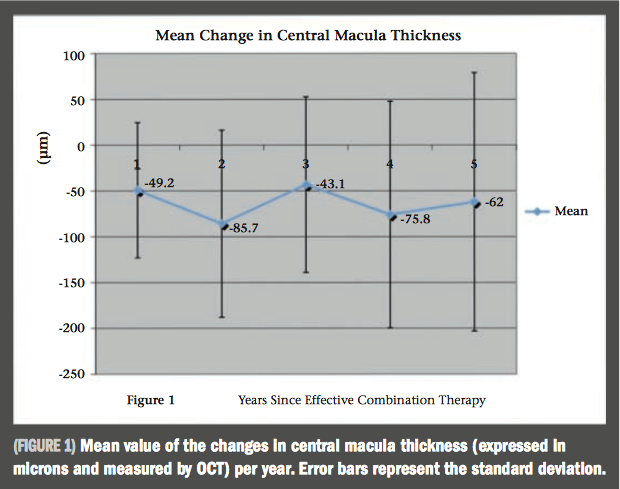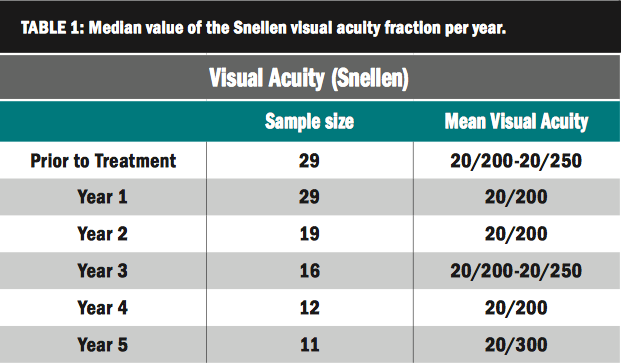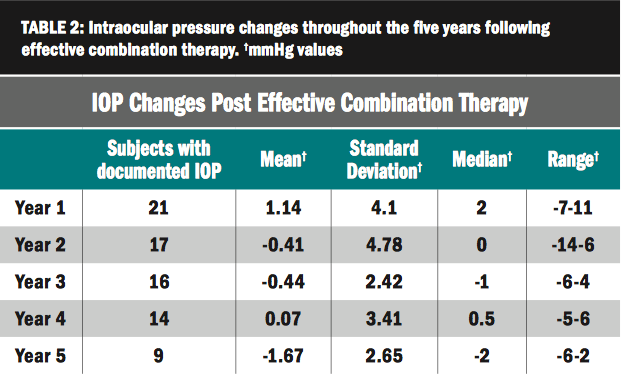Article
Lasting effects of anti-VEGF/photodynamic therapy for AMD
Author(s):
The authors present results from a retrospective chart review demonstrating effective management of exudative AMD using anti-VEGF/photodynamic combination therapy. Possible implications of these findings for clinical practice are also discussed.
Take-home message: The authors present results from a retrospective chart review demonstrating effective management of exudative AMD using anti-VEGF/photodynamic combination therapy. Possible implications of these findings for clinical practice are also discussed.
By Dr Kent Small, Mr Fadi Shaya, Dr Rosemary Silva-Garcia and Ms Colleen McLellan

The standard treatment options for neovascular age-related macular degeneration (AMD) includes photodynamic therapy (PDT) and intravitreal injections of anti-VEGF.1 Studies have shown that anti-VEGF injections are more effective than PDT as a monotherapy, still, anti-VEGF injections given at intervals ranging from 4 to 8 weeks are usually required to control neovascular membranes in wet AMD. Intravitreal injections are performed daily and although some complications can be associated with severe vision loss, risk is low when performed properly. Complications include retinal tears, retina detachments, vitreous hemorrhage, uveitis, and endophthalmitis.2–4 Previous studies have suggested that visual acuity (VA) outcomes are comparable between anti-VEGF monotherapy and anti-VEGF/PDT combination treatment, the latter with significantly fewer interventions.3,5 With further studies, a combination approach may reduce the overall need for AMD treatments as well as their potential for ocular or systemic complications.
Retrospective chart review
Our study consisted of a retrospective chart review (26 patients, 29 study eyes) from a retina specialty practice in Los Angeles, California, US, for whom combination treatment with anti-VEGF injection (bevacizumab) and PDT effectively halted the growth of neovascular membranes and the need for further treatments in one or both eyes for at least 1 year. Charts were reviewed for up to 5 years for the eyes remaining during this period. Collected data included: visual acuity (VA), central retinal thickness, intraocular pressure (IOP) and history of glaucoma, wet AMD onset and treatment history, concomitant use of anticoagulants and past history or development of cerebrovascular or cardiovascular disease. Visual acuity was measured using Snellen charts and Optical Coherence Tomography (OCT) was performed using either a Carl Zeiss OCT 3 Stratus (Carl Zeiss Meditec AG, Jena, Germany) or OPKO SD-OCT (OPKA Health Inc., Miami, Florida, USA). Descriptive statistical analyses were performed, as the dataset was too small for meaningful comparative statistical analyses.

Eight out of the 29 eyes studied were from 4 patients with bilateral exudative AMD. Overall mean age at the time PDT plus anti-VEGF therapy was 80.2 years (range 67 to 92 years). Prior to effective combination therapy, the study eyes on average were treated with 5 anti-VEGF injections (range; 1–18) or 2 PDTs on average of 2 (range; 1–8) as monotherapy. Most eyes had large chronically active CNVMs. Monotherapy was administered for an average of 16.13±17.35 months before CNVM was stabilized by combination therapy and required no further treatment for at least 1 year. Median VA before and after effective combination treatments are shown in Table 1. The mean changes in central macula thickness from baseline (prior to effective combination therapy) over 5 years are represented in Figure 1. Mean changes in IOP readings are presented in Table 2.
Risks and benefits of combination therapy
In managing any disease, one goal is to achieve the best outcome possible with the fewest interventions. Combination therapy of anti-VEGFs with PDT may offer such possibility. Anti-VEGFs have been a great advancement in wet AMD; nonetheless, they may also increase healthcare expenses.7 Besides financial concern, the need for frequent injections places burden on patients, families, and clinics.
New data suggests anti-VEGF injections are associated with increasing risk of glaucoma in addition to the risks mentioned above. One study found that with two or more intravitreal anti-VEGF injections, an IOP elevation of >5 mmHg from the baseline becomes more likely.8 Secondary glaucoma and other aforementioned side effects are factors in determining duration and frequency of care for exudative AMD.
Combination treatment in cancer attacks different pathways, allowing for better outcomes while decreasing risk and side effects. Similarly, the combination therapy utilized herein seems to limit the risks and chronic exposure to anti-VEGF agents while achieving at least similar visual outcomes as monotherapy. In our relatively small study, we found no new events of cerebrovascular accidents or ischemic heart disease in the years observed after effective combination therapy, with the exception of one case of new onset of atrial fibrillation. The risk of these adverse events has actually been reported to be higher in PDT monotherapy than in anti-VEGF injection monotherapy.9 Further research is needed to determine whether the benefits of combination therapy for exudative AMD may outweigh the slightly increased risk of stroke or heart attack with PDT. Thirteen of our patients had been on aspirin prior to, during and following combination treatment. We found no evidence that aspirin contributed to adverse outcomes.
Study data analysis
Our study was inconclusive as to why the eyes responded effectively in the long-term to combination therapy. It appears that with combination therapy, exudative AMD can be effectively managed and a patient’s exposure to side effects minimized. When compared to indefinite treatment with mostly anti-VEGF injections, combination therapy may also improve quality of life by shortening the overall duration of treatment.

The obvious weaknesses of this study are the relative small size, retrospective chart review, and that we do not have the total number of patients treated with combination therapy (a denominator). Without a denominator we are unable to provide a ‘success rate,’ which may introduce a selection bias, but the major point of this study is that despite the results of the DENALI and MONT BLANC studies,10,11 there are a significant number of patients who do very well with combination therapy in the real world. As stated in the 12-month MONT BLANC and DENALI studies, non-inferiority of combination treatment over anti-VEGF monotherapy did not show a statistical significance. The fact that these studies found no statistically significant non-inferiority does not mean that non-inferiority does not exist; it could indicate that the studies were not powered to detect the treatment effect. As with any prospective randomized trial, MONT BLANC and DENALI provides general guidelines based on their specific study design. This can have limited application to the real world.
It should be noted, although not mentioned in our publication, that many of our subjects had CNVMs larger than 6000 microns in diameter and most were predominantly occult. This severe clinical presentation was particularly common in the early days of anti-VEGFs where patients had no prior treatment. Some of the lesions were larger than 8000 microns, necessitating multiple slightly overlapping PDT laser spots. In other words, these were some of the worst wet AMD patients in the practice. These patients had little hope for improvement or even stabilization with anti-VEGF monotherapy. We found calculating the size and percentage of the CNVM lesion that was “classic” to be unrewarding, time consuming and generally unnecessary. Also not mentioned, is that we used reduced fluence (by reducing power, not time) PDT within 1 week of the anti-VEGF injection.
Combination therapy: an overlooked approach
It is disheartening that current retina fellows seem to have less training in PDT and doctors aren’t using it as often as anti-VEGF because of cost and inconvenience. Additionally, PDT lasers are becoming progressively more difficult to obtain. However, patients treated with both PDT and anti-VEGF resulted in equivalent outcomes with fewer treatments. For us, this outweighs the cost and inconvenience of PDT. Most pharmaceutical macular degeneration studies seem to focus only on agent monotherapy versus monotherapy of a pre-existing agent. Once approved by the FDA, we physicians seem to get stuck in the mode established only by the design of the pivotal trial of the monotherapy agent. We need to break out of this fixed and static mode of thinking and be willing and interested in trying different combinations of treatments. Perhaps genotyping these subjects for AMD risk alleles might reveal other factors for favourable responders to combination therapy.
References
- P.Y. Ramulu et al., Arch. Ophthalmol. 2010;128(10):1335–1340.
- CATT Research Group; D.F. Martin et al., Ophthalmology. 2012;119(7):1388–1398.
- N.M. Bressler et al., Arch. Ophthalmol. 2009;127(1):13–21.
- S. Day et al., Am. J. Ophthalmol. 2011;152(2):266–272.
- J.S. Heier et al., Arch. Ophthalmol. 2006;124(11):1532–1542.
- US Census Bureau. 2008 National Population Projections. US Census Bureau. Available from: https://www.census.gov/population/projections/data/national/2008/summarytables.html.
- R.J. Brechner et al., Am. J. Ophthalmol. 2010;151(5):887–895.
- Q.V. Hoang et al., Opthalmology . 2012;119(2):321–326.
- L.H. Curtis et al., Arch. Ophthalmol. 2010;128(10):1273–1279.
- P.K. Kaiser et al. Ophthalmology. 2012;119(5):1001–1010.
- M. Larsen et al., Ophthalmology. 2012;119(5):992–1000.
Dr Kent Small
Dr Small is a Physician and Founder at the Macula and Retina Institute, Glendale, California, USA.
Mr Fadi Shaya
Mr Shaya is the Research/Study Coordinator for Dr Small at Macula and Retina Institute, Glendale, California, USA.
Dr Rosemary Silva-Garcia and Ms Colleen McLellan contributed to data collection for the original published study.
The authors have no financial disclosures relating to the content of this article. A small investigator-sponsored trial grant was provided by Valeant Pharmaceuticals International, Inc. for the original study.
Newsletter
Don’t miss out—get Ophthalmology Times updates on the latest clinical advancements and expert interviews, straight to your inbox.




